Birds come in various categories based on their physical and behavioral characteristics. One of the categories that birds are classified under is carnivorous birds.
These birds prefer hunting and consuming meat as their primary source of food. The carnivorous birds list includes various types of birds such as eagles, hawks, owls, vultures, falcons, and many others.
These birds have distinct morphological and physiological adaptations that enable them to hunt and consume prey efficiently. Their sharp talons, hooked beaks, and excellent eyesight make them formidable hunters, and they are often at the top of the food chain in their environment.
This article will explore the carnivorous birds list, their characteristics, and their role in the ecosystem.
1. Kingfisher
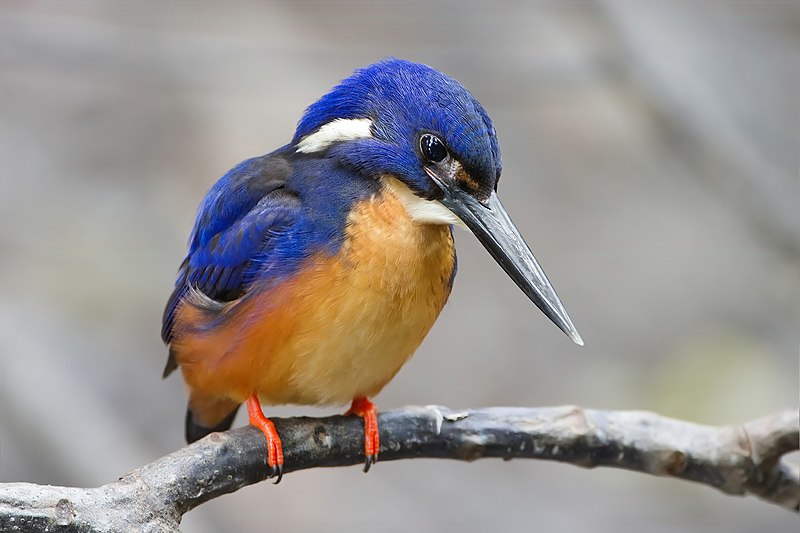
Kingfishers are a vibrant and unique family of birds, with most species found in tropical regions across Africa, Asia, Oceania and Europe.
Their bright colors make them easily identifiable among the foliage of deep forests near calm ponds or rivers.
They come in three subfamilies: tree kingfishers (Halcyoninae), water kingfishers (Cerylinae) and river kingfishers (Alcedinidae).
Kingfisher birds have short legs used for perching along branches overhanging streams or lakes; they also possess strong beaks perfect for catching fish.
These little hunters will remain motionless as if suspended from thin air until an unsuspecting prey comes within reach.
Then they swoop down quickly to grab their meal. With 116 different species making up this incredible family, there’s something special about every single one.Scientific classification:
| Kingdom | Animalia |
| Phylum | Chordata |
| Class | Aves |
| Order | Coraciiformes |
| Suborder | Alcedines |
| Family | Alcedinidae Rafinesque, 1815 |
Also Featured In: Common Birds in India, Birds You’ll Find in Moldova
2. Bald Eagle
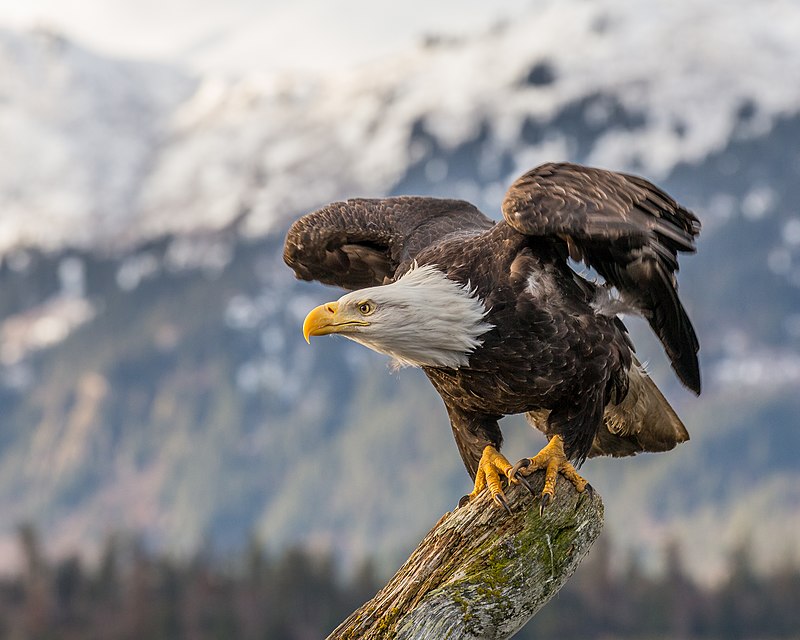
The majestic Bald Eagle is a bird of prey found in North America and recognized as the national symbol of the United States.
With its distinctive white head, brown body and striking yellow beak, this sea eagle has two known subspecies that form a species pair with the White-tailed Eagle.
It inhabits much of Canada, Alaska all states in the US contiguous area and Northern Mexico near large bodies of water where they feed mainly on fish.
These birds have an impressive wingspan ranging from 1.8 to 2 meters depending on their size making them one of nature’s most magnificent creatures.Scientific classification:
| Kingdom | Animalia |
| Phylum | Chordata |
| Class | Aves |
| Order | Accipitriformes |
| Family | Accipitridae |
| Genus | Haliaeetus |
| Species | H. leucocephalus |
Also Featured In: Most Common United States Birds, Birds That Live in Colorado
3. Osprey

The Osprey is a majestic bird of prey with an incredibly wide habitat range. It has distinctive brown upperparts and greyish head and underparts, making it easily identifiable in the skies above many regions across the world.
With a wingspan of up to 180cm (71in) and body length reaching 60cm (24in), this large raptor specializes in hunting for fish, soaring high over rivers as well as coasts searching for its next meal.
Despite living near water sources, they can also be found inhabiting mountainsides or even woodlands, proving their incredible adaptability. An impressive species that truly deserves admiration.Scientific classification:
| Kingdom | Animalia |
| Phylum | Chordata |
| Class | Aves |
| Order | Accipitriformes |
| Family | Pandionidae |
| Genus | Pandion |
| Species | P. haliaetus |
Also Featured In: Most Popular Bird Species in North America, Ukrainian Birds You Should Know
4. Turkey Vulture
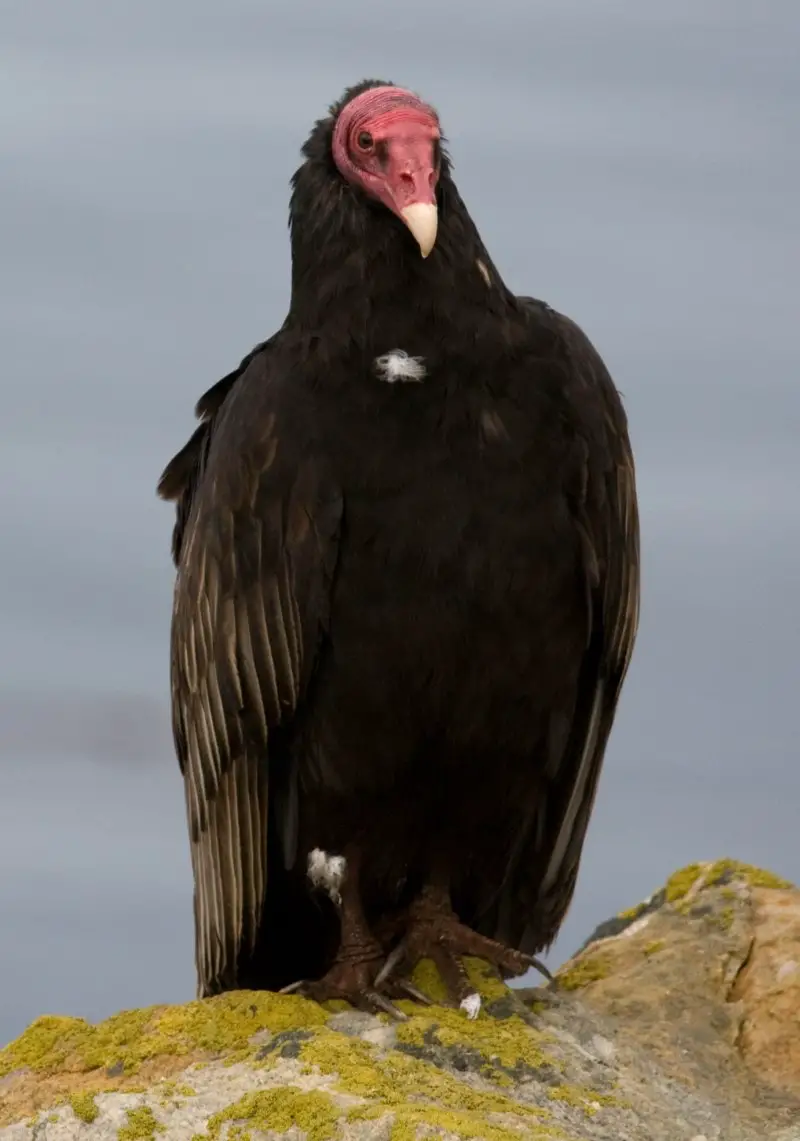
The turkey vulture is a large bird of prey that can be found in many parts of the world. It has a wingspan of up to 6 feet and its feathers are mostly black with brownish-red patches on the underside which give it an overall dark red appearance.
Its head is bald, which helps protect it from getting overheated when flying long distances looking for food.
The Turkey Vulture usually feeds off carrion but will also feed on fruit and insects.
Its keen eyesight allows them to spot potential meals from miles away while they soar through the sky using their broad wings and thermal air currents to stay aloft without expending much energy.
They are very important scavengers as they keep ecosystems healthy by consuming dead animals before disease can spread amongst living creatures or contaminate local water sources like rivers or lakesScientific classification:
| Kingdom | Animalia |
| Phylum | Chordata |
| Class | Aves |
| Order | Accipitriformes |
| Family | Cathartidae |
| Genus | Cathartes |
| Species | C. aura |
Also Featured In: Top Birds Found in Mexico, Birds that Live in the Deserts
5. Grebes
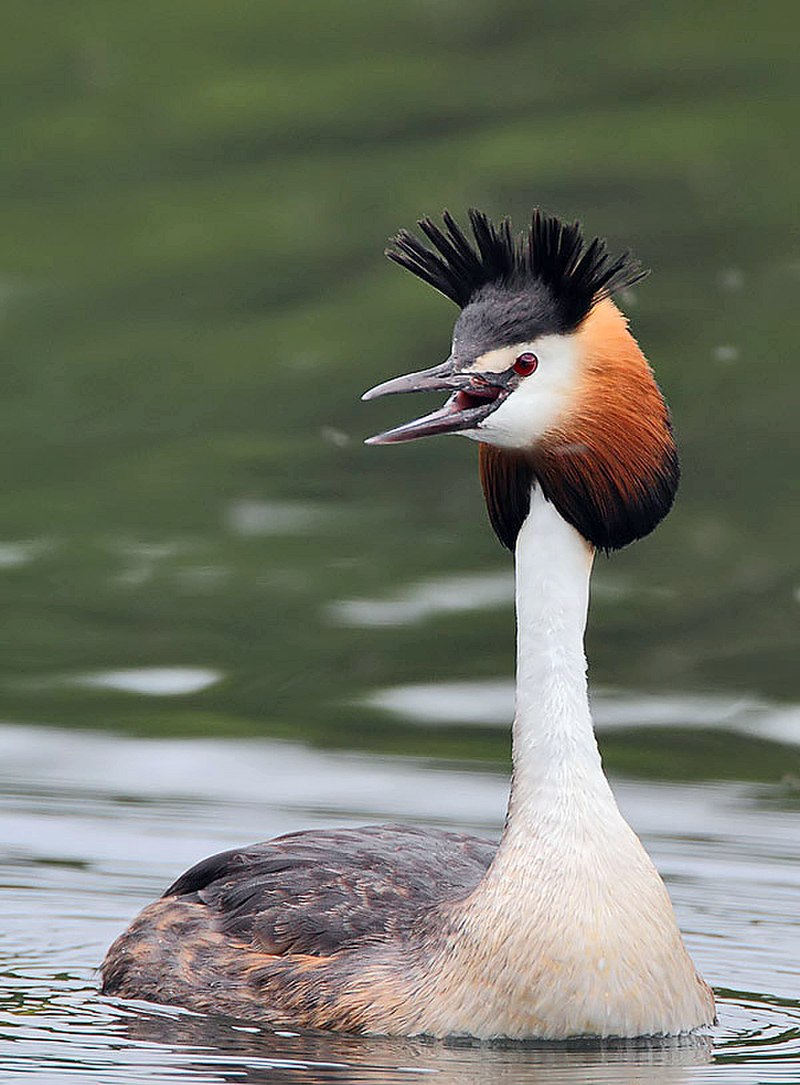
Grebes are a type of diving bird found in freshwater habitats around the world. They belong to the order Podicipediformes and have 22 species that exist across six genera.
Some species can also be found in marine environments during their migration or winter season, and some even live flightless lives on stable lakes.
Grebes vary greatly between regions; for example, they range from 4-32 inches long with anywhere from 8-30 ounces of weight depending on which species it is.
Their plumage may be black, browns/grays or whites but usually consist of bright colors such as yellows, blues and greens while underwater they use these feathers to help them streamline through the water quickly.Scientific classification:
| Kingdom | Animalia |
| Phylum | Chordata |
| Class | Aves |
| Clade | Neoaves |
| Clade | Mirandornithes |
| Order | Podicipediformes Fürbringer, 1888 |
| Family | Podicipedidae Bonaparte, 1831 |
Also Featured In: Common Birds in Japan, Water Birds Live around Us
6. Shrike
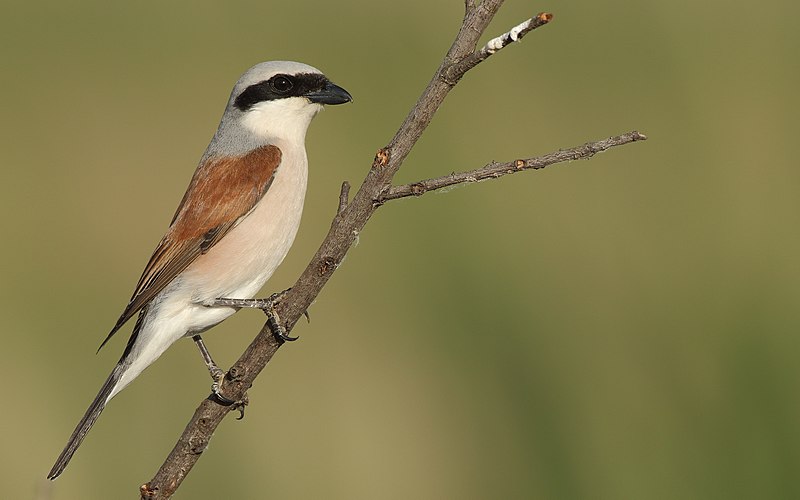
Shrikes are small passerine birds of the family Laniidae, with 34 species in four genera. They get their name from Old English word “scrīc”, which refers to their shriek-like call.
These birds have earned the nickname ‘butcherbirds’ due to their feeding habits; they impale prey on thorns or barbed wire fences for later consumption.
Shrikes also tend to be aggressive predators and hunt a wide range of animals such as insects, small reptiles, rodents and even other smaller bird species.
In terms of physical appearance, these songbirds can vary greatly depending on the specific genus but usually boast a large hooked bill atop an impressive crest along with bright colors like gray, black or brownish hues across its feathers.
It’s clear shrike is quite remarkable creature that has gained notoriety for both hunting prowess and distinctive vocalizations.Scientific classification:
| Kingdom | Animalia |
| Phylum | Chordata |
| Class | Aves |
| Order | Passeriformes |
| Superfamily | Corvoidea |
| Family | Laniidae Rafinesque, 1815 |
Also Featured In: Egyptian Birds, Italian Birds You Should Know
7. Falcon
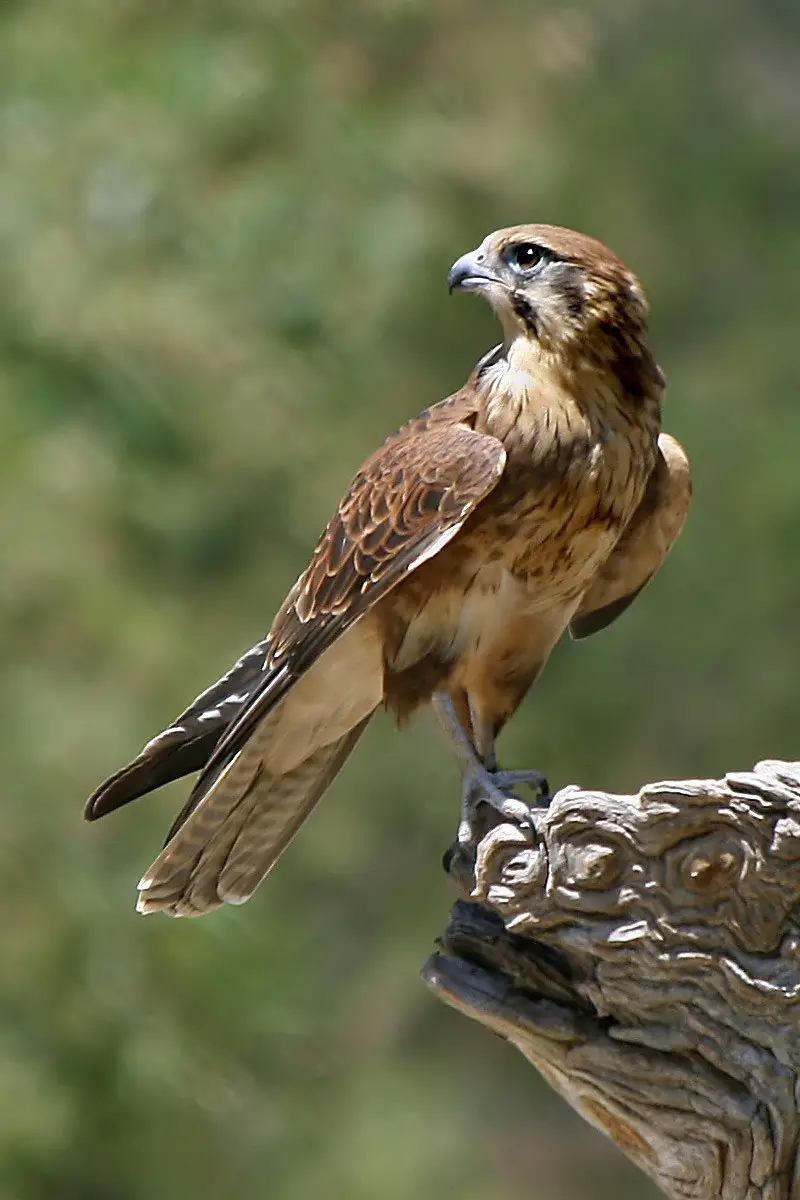
Falcons are majestic birds of prey found in almost all parts of the world, except Antarctica. They have long, slender wings that allow them to fly swiftly and change directions quickly.
As adults they feed on small animals such as mice and insects, but when young their diet consists mainly of carrion or food provided by their parents.
Falcons use a range of techniques for hunting including hovering high up above potential prey before diving down at great speed to catch it during flight.
Additionally they also ambush unsuspecting victims from concealed perches close to the ground.
These remarkable hunters can even take advantage of thermal currents rising off warm surfaces like roads which give them an extra boost while flying.Scientific classification:
| Kingdom | Animalia |
| Phylum | Chordata |
| Class | Aves |
| Order | Falconiformes |
| Family | Falconidae |
| Subfamily | Falconinae |
| Genus | Falco Linnaeus, 1758 |
Also Featured In: Most Common Nature Birds, Birds of Symbolism
8. Northern Goshawk
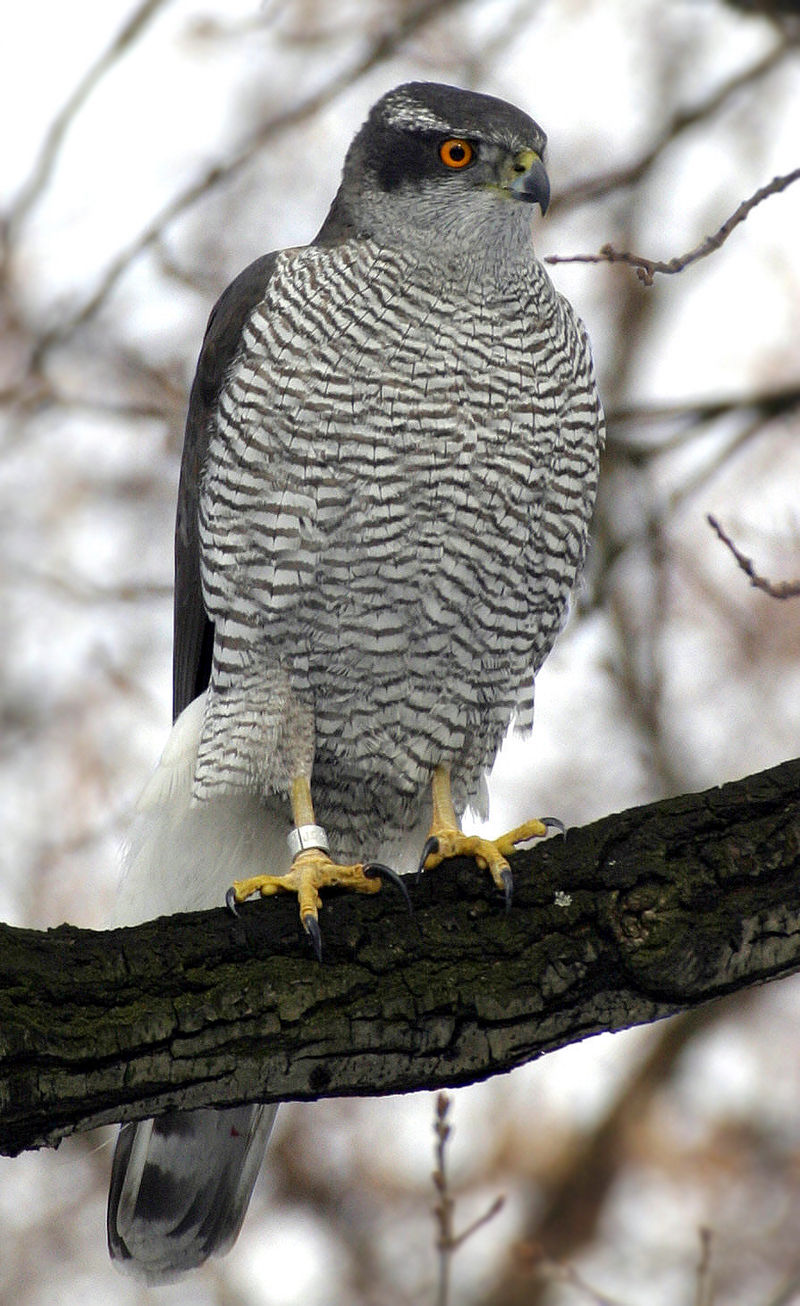
The Northern Goshawk is a medium-large bird of prey belonging to the Accipitridae family. It has been known as one of the true hawks, with “Accipiter” meaning hawk in Latin and “gentilis” referring to its noble characteristics.
They are found worldwide, most commonly in wooded areas such as forests or thickets where they hunt small birds and mammals.
The males have spotted grey upperparts while females tend to be fully brown above with some lighter barring on their underparts.
These raptors rely heavily on speed and agility when hunting from either perches or during aerial dives at high speeds for their prey which makes them formidable predators that can reach up to 40 mph.Scientific classification:
| Kingdom | Animalia |
| Phylum | Chordata |
| Class | Aves |
| Order | Accipitriformes |
| Family | Accipitridae |
| Genus | Accipiter |
| Species | A. gentilis |
Also Featured In: Native Birds Of Germany, Belarus Birds You Should Know
9. Barn Owl
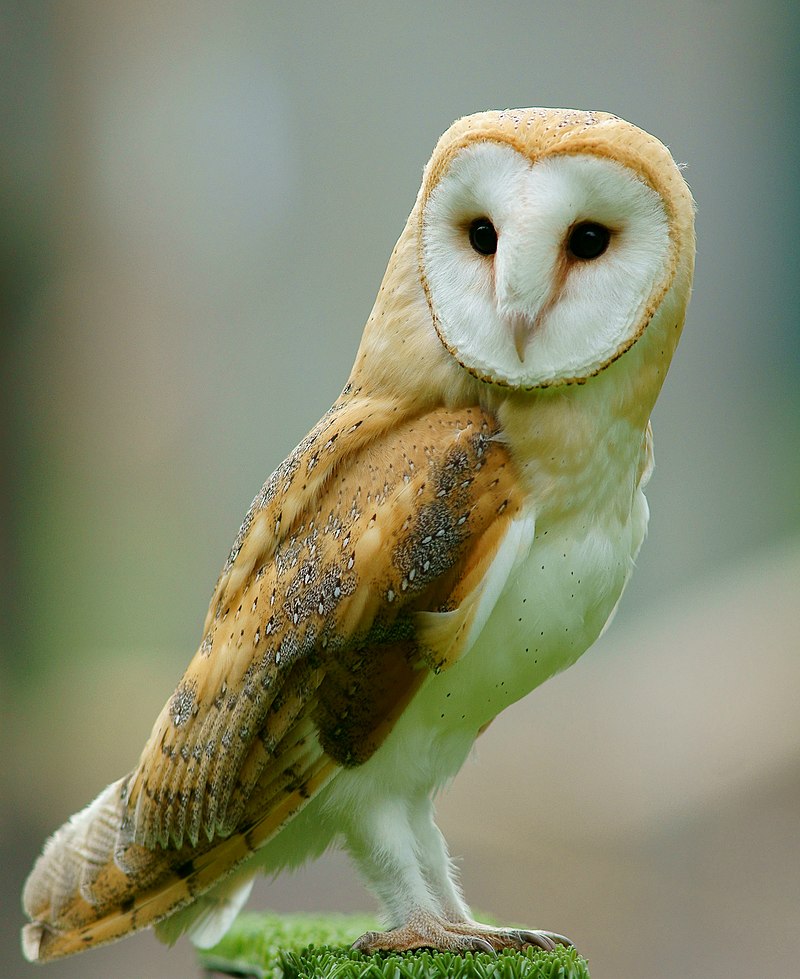
Barn owls are a beautiful and fascinating species of birds found around the world, with the exception of polar and desert regions, most of Indonesia and some Pacific Islands.
They have large eyes, thin legs and long wings that help them to hunt silently in low light conditions.
Their white colouring helps them blend into their surroundings making it easier for them to catch prey.
Barn owls are nocturnal hunters who use their impressive hearing capabilities to locate rodents moving within vegetation or tunnels beneath the ground.
They also feed on insects such as beetles, moths etc., which they can detect from high up in flight using their excellent vision even at night time.
The barn owl plays an important role in balancing ecosystems by controlling rodent populations which is why they should be protected wherever possible so that this vital service continues uninterruptedly.Scientific classification:
| Kingdom | Animalia |
| Phylum | Chordata |
| Class | Aves |
| Order | Strigiformes |
| Family | Tytonidae |
| Genus | Tyto |
| Species | T. alba |
Also Featured In: Birds You’ll Find in Zoo, European Birds
10. Eurasian Sparrowhawk
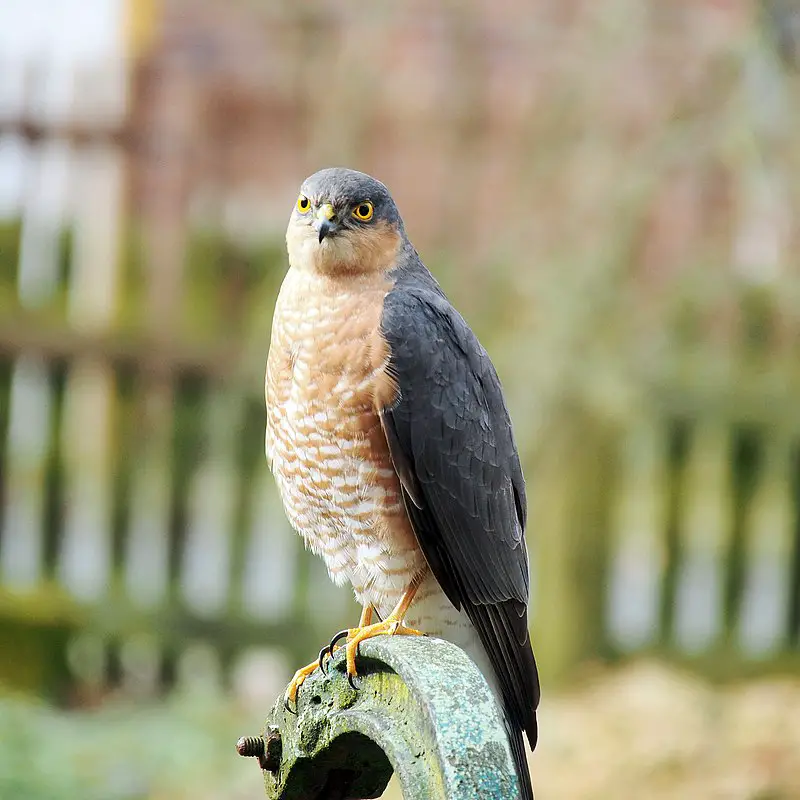
The Eurasian sparrowhawk is a small bird of prey belonging to the Accipitridae family. It has distinct blue-grey upperparts and orange barred underparts, while females and juveniles appear brown with brown barring underneath.
The female of this species can grow up to 25% larger than males which makes it one of the largest size differences among birds in its kind.
They are found all over Europe, Asia and North Africa where they hunt for quarry such as mammals, lizards or even other smaller birds using their powerful talons to catch them from aerial dives.
They have adapted well to human presence by nesting on buildings or urban parks due to lack natural habitats making them an interesting creature for wildlife observation across cities too.Scientific classification:
| Kingdom | Animalia |
| Phylum | Chordata |
| Class | Aves |
| Order | Accipitriformes |
| Family | Accipitridae |
| Genus | Accipiter |
| Species | A. nisus |
Also Featured In: Birds of United Kingdom, Most Common Scotland Birds
11. Common Buzzard
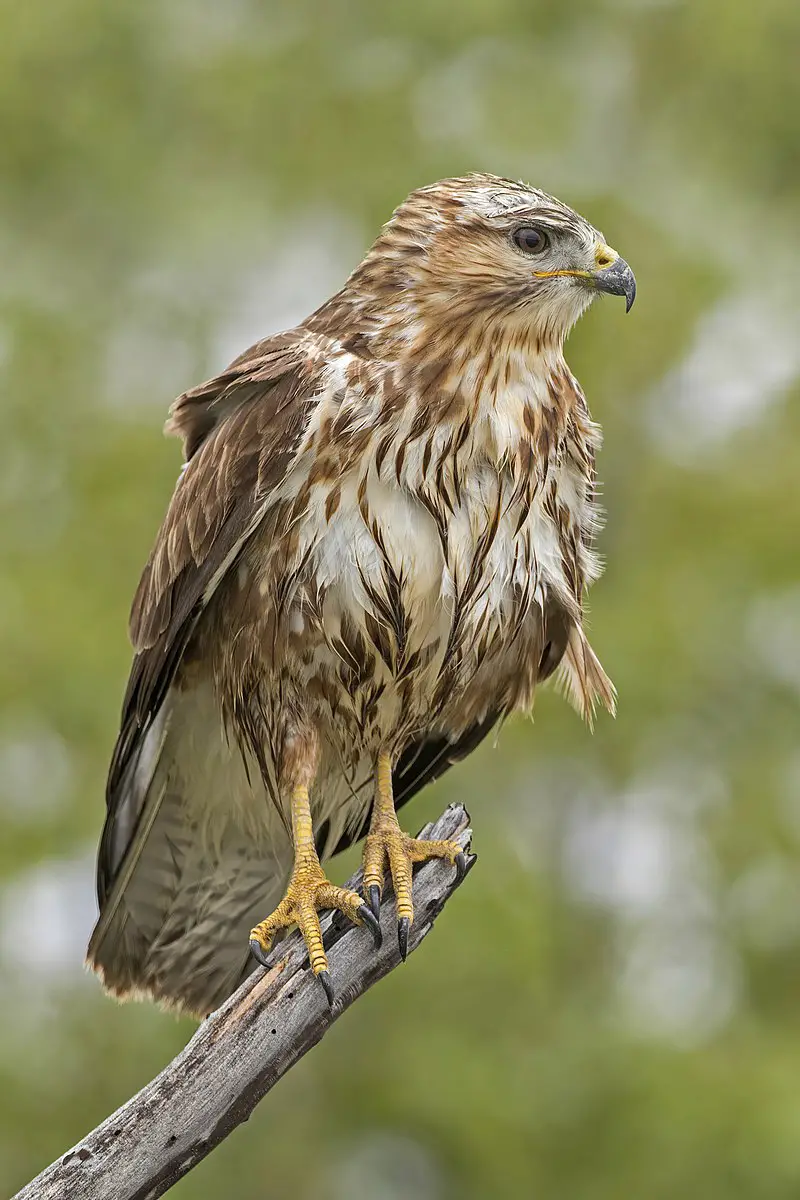
The common buzzard is a large bird of prey found across much of Europe, the Palearctic region and parts of Asia. This species has medium to dark brown plumage with lighter streaks on its body.
It has broad wings which are useful for soaring high in search of food such as small rodents, lizards, amphibians and insects.
Buzzards often hunt from a perch or while hovering above open areas like fields and meadows where they can easily spot their prey below.
They also take advantage of thermals rising up from warm ground during hot summer days to gain altitude without expending energy flapping their wings.
In addition to hunting alone, these birds will sometimes join forces with others when scavenging carrion or chasing away predators that threaten their nests full of eggs or young chicksScientific classification:
| Kingdom | Animalia |
| Phylum | Chordata |
| Class | Aves |
| Order | Accipitriformes |
| Family | Accipitridae |
| Genus | Buteo |
| Species | B. buteo |
Also Featured In: Asian Birds, Moscow Birds You Need to See
12. Stork
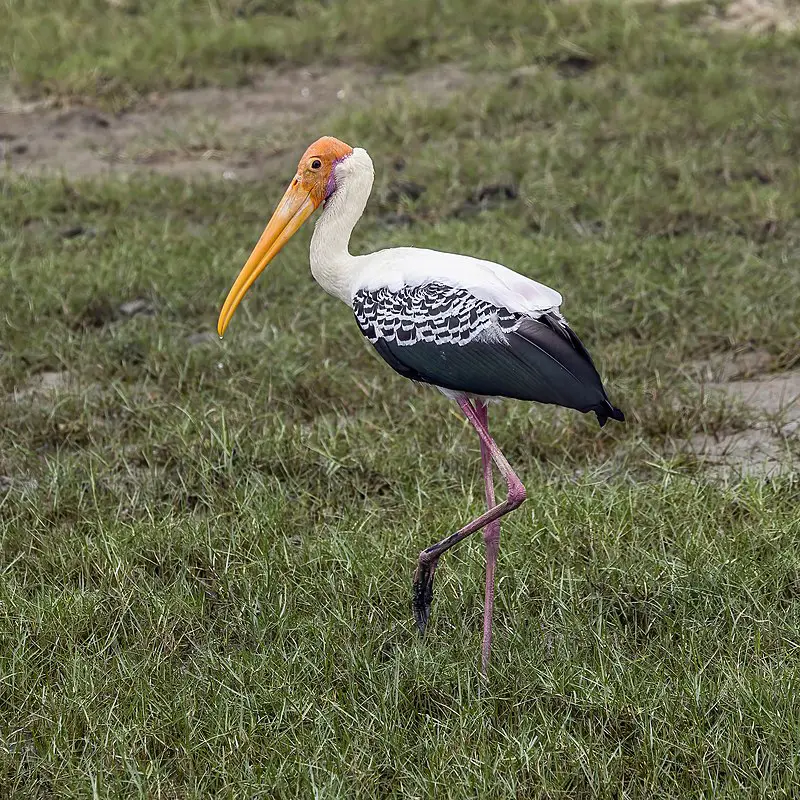
Storks are majestic birds, easily recognizable with their long necks and legs. They belong to the family Ciconiidae, making up the order Ciconiiformes.
Storks inhabit many areas around the world but generally prefer drier habitats than other wading birds like herons or ibises which have been moved to separate orders.
Despite being large in size they can be quite graceful in flight as well as when hunting for food such as insects, small mammals and reptiles near shallow waters.
During nesting season stork pairs build nests on high trees or platforms made of sticks and twigs where they lay eggs that hatch after about a month of incubation time by both parents taking turns sitting on them warmly until hatching day.Scientific classification:
| Kingdom | Animalia |
| Phylum | Chordata |
| Class | Aves |
| Clade | Aequornithes |
| Order | Ciconiiformes Bonaparte, 1854[1] |
| Family | Ciconiidae J. E. Gray, 1840[1] |
Also Featured In: Native South Korean Birds, Birds of Sweden
13. Cinereous Vulture
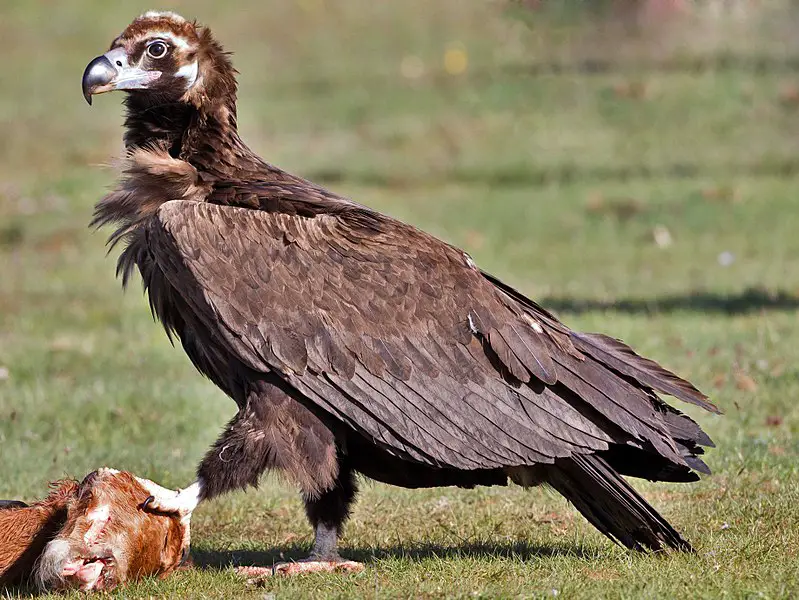
The cinereous vulture, also known as the black vulture, monk vulture and Eurasian black vuture is a large raptor found in temperate Eurasia. It has an impressive wingspan of 3.1 metres (10 feet) with a body length of 1.2 metres (3 ft 11in).
They are the largest Old World Vultures and can reach weights up to 14 kilograms(31 lbs).
Their diet consists mainly of carrion but they have been recorded taking live prey such as rodents or hares which allows them to search for food over wide areas quickly.
These birds usually hunt alone during daylight hours due their eyesight being well adapted at picking out carcasses from far away distances while soaring high in the sky above open grasslands or wooded hillsides where they breed seasonally between late winter and early autumn typically laying one egg per pair each year.Scientific classification:
| Kingdom | Animalia |
| Phylum | Chordata |
| Class | Aves |
| Order | Accipitriformes |
| Family | Accipitridae |
| Genus | Aegypius |
| Species | A. monachus |
Also Featured In: Armenian Birds You Should Know, Scavengers Birds You Should Know
14. Andean Condor
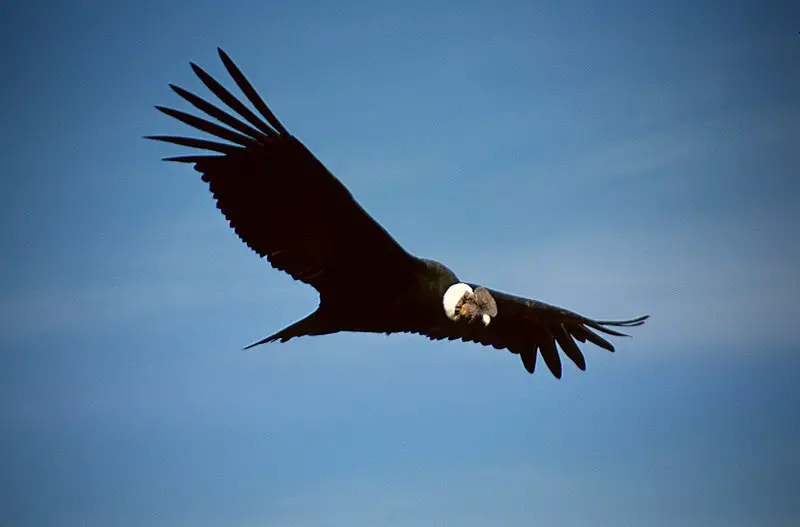
The Andean condor is a giant South American Cathartid vulture and the only member of its genus.
Found in the Andes mountains and along Pacific coasts, it is thought to be the largest flying bird on Earth by weight and wingspan with a maximum wingspan reaching up to 10 feet 10 inches (3.3 m) and weighing 33 lbs (15 kg).
It has mainly black plumage which helps keep it warm at high altitudes, while white patches adorn its head, neck, chest as well as underwing coverts.
Its powerful bill allows it to consume carrion efficiently while also being able to crack bones for nutrition when necessary.
The amazing flight capabilities of this majestic creature allow them soar through air thermals effortlessly; making them an impressive sight against clear blue skies.Scientific classification:
| Kingdom | Animalia |
| Phylum | Chordata |
| Class | Aves |
| Order | Accipitriformes |
| Family | Cathartidae |
| Genus | Vultur Linnaeus, 1758 |
| Species | V. gryphus |
Also Featured In: Common Birds in Colombia, Aviary Birds You Should Know
15. King Vulture
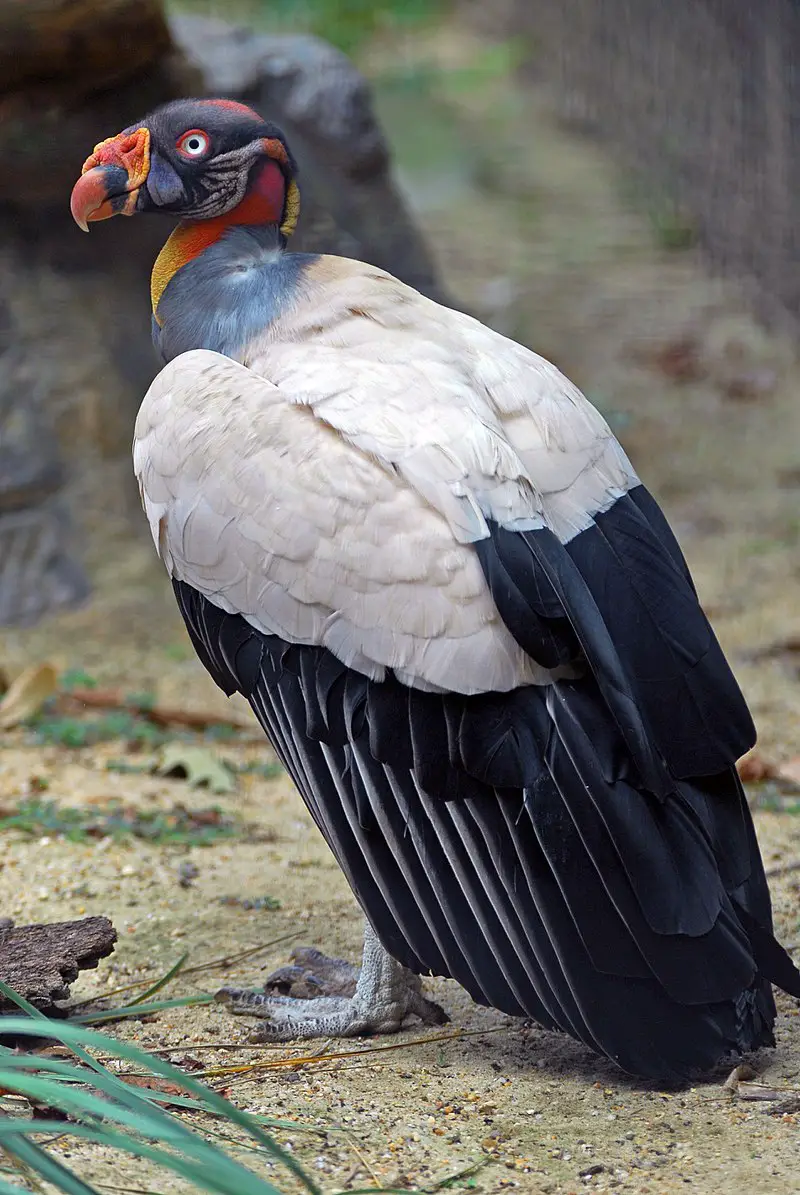
The King Vulture is a majestic bird found in Central and South America. It has striking white plumage with black accents, and its head is topped by a bright yellow crest.
With long wingspan of up to 4 feet, this vulture soars gracefully through the sky. Its large size allows it to dominate other scavenging birds at carcasses; although not as powerful as some raptors, the king vulture will protect what belongs to it fiercely.
The diet of these elegant creatures consists mainly of carrion such as dead mammals or fish that they spot from far away using their excellent vision.
They also occasionally eat eggs or nestlings if food is scarce during dry seasons.
This fascinating species plays an important role in keeping ecosystems healthy by removing dead animals from landscapes quickly before diseases spread further into populationsScientific classification:
| Kingdom | Animalia |
| Phylum | Chordata |
| Class | Aves |
| Order | Accipitriformes |
| Family | Cathartidae |
| Genus | Sarcoramphus |
| Species | S. papa |
Also Featured In: Birds That Live in the Jungle, Rainforest Birds You Should Know
16. Harpy Eagle
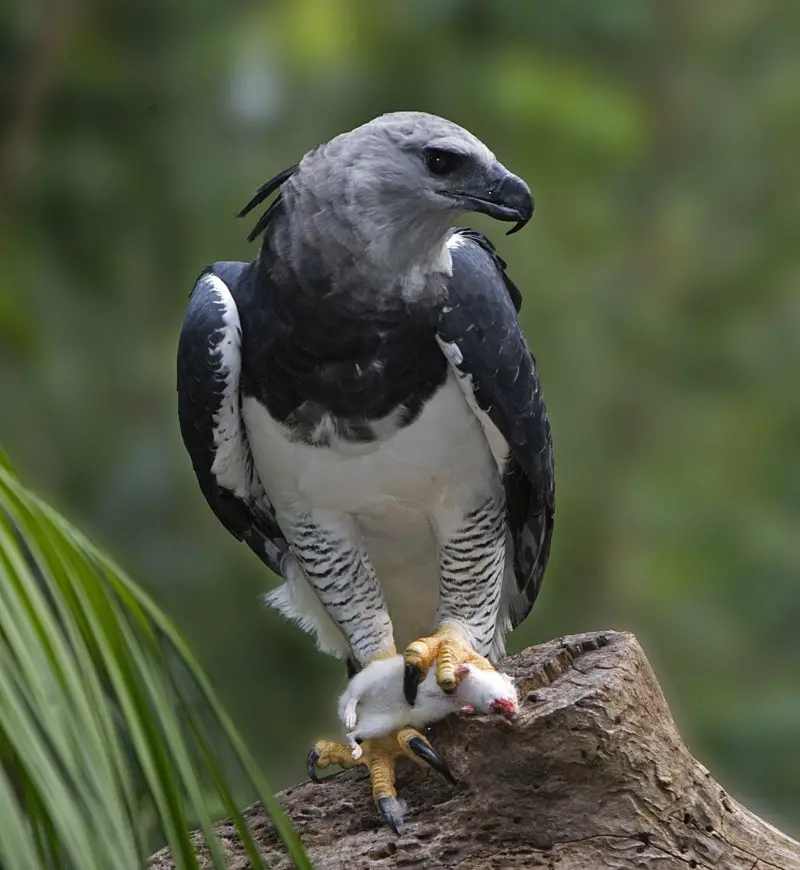
The Harpy Eagle is a magnificent bird of prey found in the tropical forests of Central and South America. It is the largest eagle on Earth, possessing an impressive wingspan that can reach up to 7 feet across.
Its powerful talons are its most distinguishing feature, being able to grasp even large animals such as monkeys or sloths with ease.
The majestic raptor has slate-gray feathers on its back and head which contrast against white undersides and yellow legs.
These birds live alone for much of their life but will come together during breeding season when they construct elaborate nests high off the ground in tall trees.
People have long been fascinated by this species’ impressive size and strength—it truly deserves its nickname as “the lord of skies”.Scientific classification:
| Kingdom | Animalia |
| Phylum | Chordata |
| Class | Aves |
| Order | Accipitriformes |
| Family | Accipitridae |
| Subfamily | Harpiinae |
| Genus | Harpia Vieillot, 1816 |
| Species | H. harpyja |
Also Featured In: Most Common Birds in South America Birds, Common Latin America Birds
17. Pelican
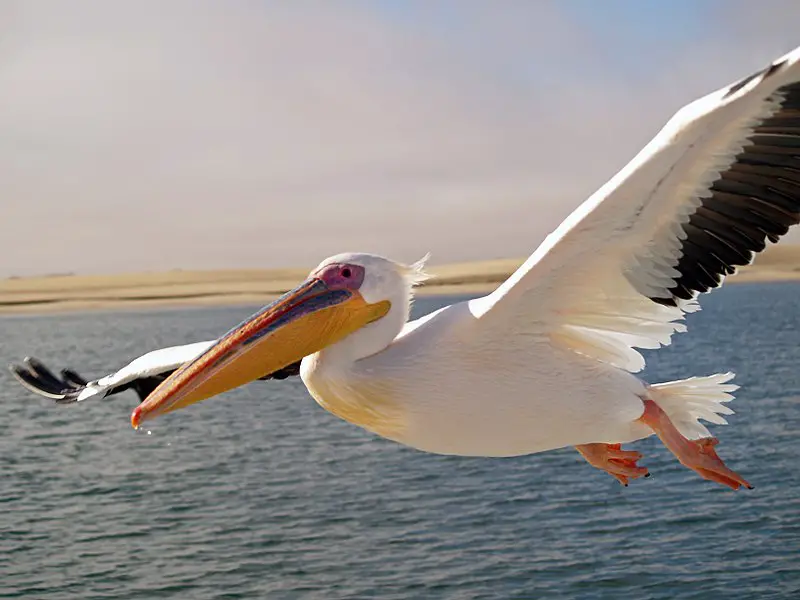
Pelicans are a large water bird and form part of the family Pelecanidae. They have long beaks, allowing them to scoop up prey from both land and sea with ease.
Their most distinctive feature is their huge throat pouch which they use to drain water before swallowing their food.
Most pelican species have predominantly pale plumage however exceptions such as the brown and Peruvian pelicans exhibit darker colouring.
The bill, face skin and pouch of all Pelican species become brightly coloured during breeding season in order to attract mates.
Pelicans can often live up to 25 years due to the fact that they eat mostly fish which provides them with enough nutrients for longevity.Scientific classification:
| Kingdom | Animalia |
| Phylum | Chordata |
| Class | Aves |
| Order | Pelecaniformes |
| Family | Pelecanidae |
| Genus | Pelecanus Linnaeus, 1758 |
Also Featured In: Most common birds in Australia, Most Common Romanian Birds
18. Red-Tailed Hawk
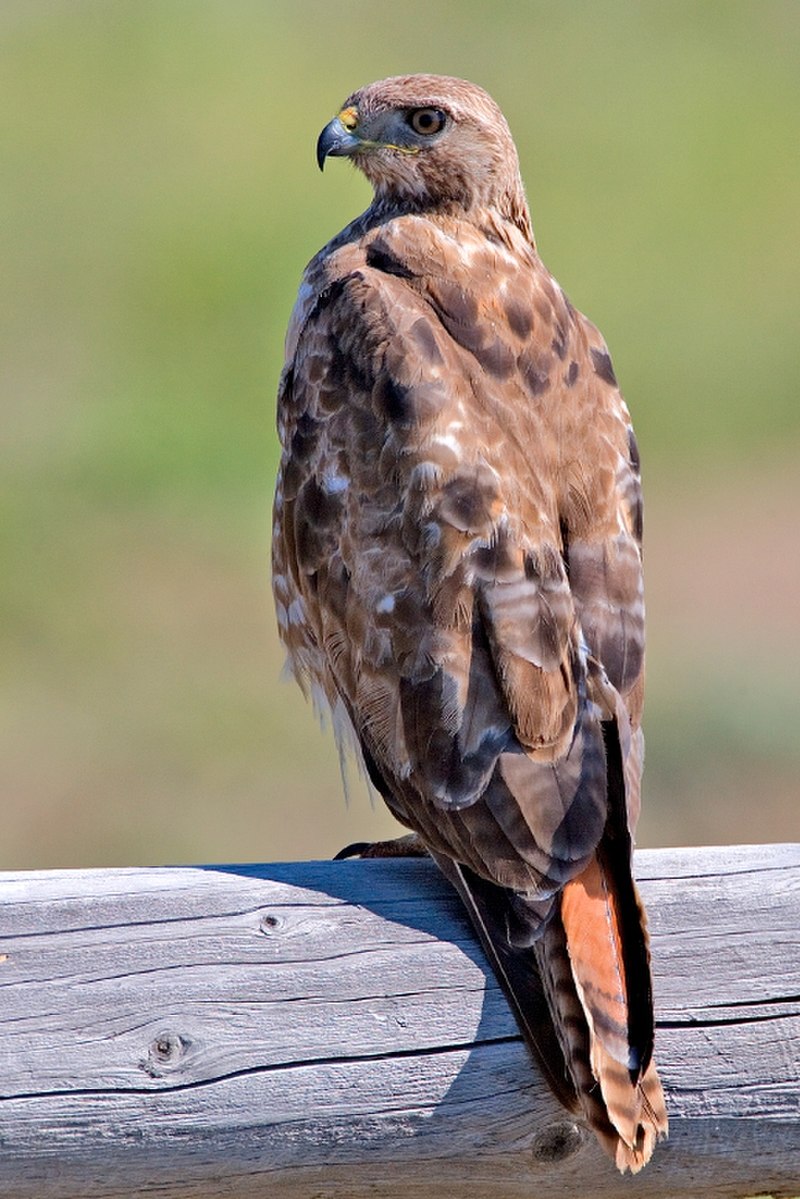
The Red-tailed Hawk is a majestic bird of prey with its distinctive red tail. It can be found throughout North America, from Alaska in the north to Panama and the West Indies in the south.
This species belongs to Buteo genus, which makes it one of most common raptors on earth.
These hawks mainly hunt small mammals such as rabbits or squirrels but also feed on reptiles and birds during migration season.
Unlike other predator birds, they prefer open areas for hunting like fields or grasslands rather than dense forests.
They build their nests high up on trees where they stay all year long unless disturbed by humans or animals nearby.
Their presence has become an iconic part of American culture due to their frequent sightings around homes and parks alike making them beloved creatures among people everywhere.Scientific classification:
| Kingdom | Animalia |
| Phylum | Chordata |
| Class | Aves |
| Order | Accipitriformes |
| Family | Accipitridae |
| Genus | Buteo |
| Species | B. jamaicensis |
Also Featured In: Dominican Republic birds, Birds Live in Arkansas
19. Roadside Hawk
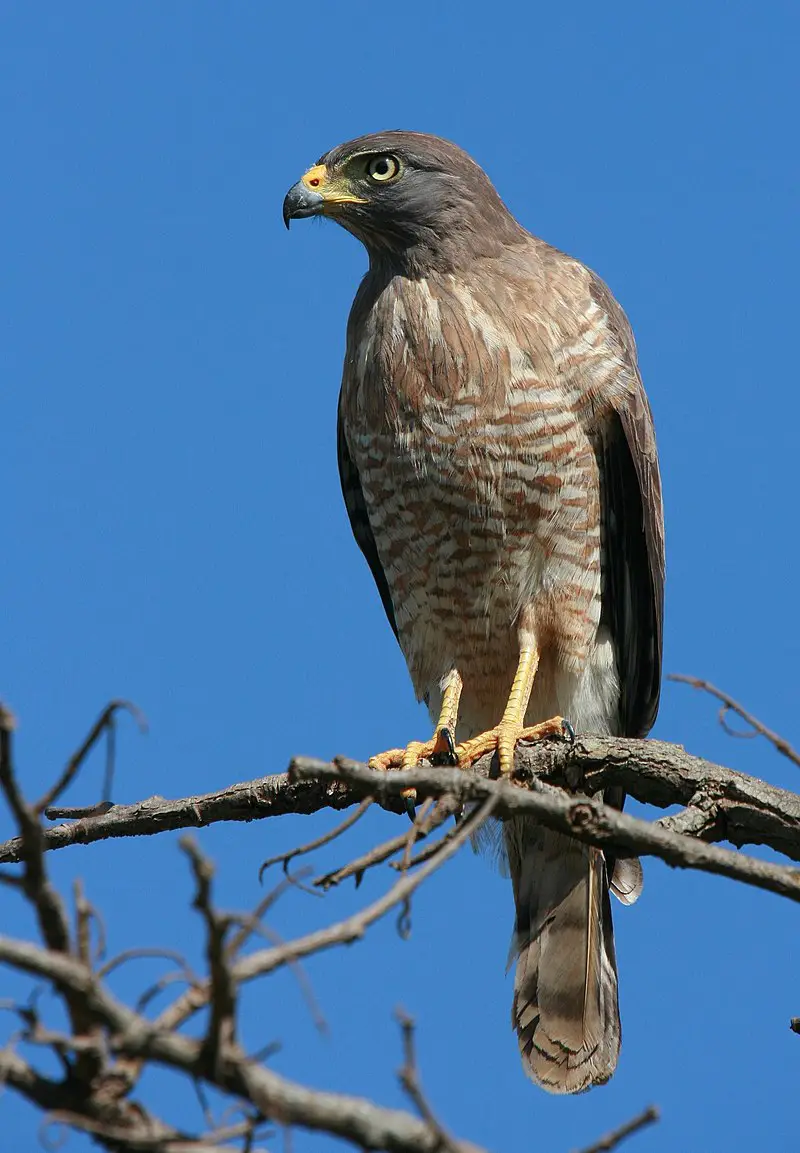
The Roadside Hawk is a small bird of prey found in the Americas. It has many subspecies, and its vocal nature makes it one of the most common raptors in its range.
Its scientific name is Rupornis magnirostris, which was formally described by German naturalist Johann Friedrich Gmelin back in 1788.
This hawk typically feeds on insects like grasshoppers and beetles as well as some smaller birds or mammals if available.
They also feed on carrion (dead animals) when other food sources are lacking or unavailable.
The roadside hawks’ nests can be seen near roadsides, agricultural fields and pastures where they hunt for their prey during the day time but roost at night to avoid predation from larger predators such as owls.
These bold hunters have adapted very well to human disturbance and make an important part of local ecosystems with their hunting capabilitiesScientific classification:
| Kingdom | Animalia |
| Phylum | Chordata |
| Class | Aves |
| Order | Accipitriformes |
| Family | Accipitridae |
| Genus | Rupornis Kaup, 1844 |
| Species | R. magnirostris |
Also Featured In: Suriname birds,
20. Penguins
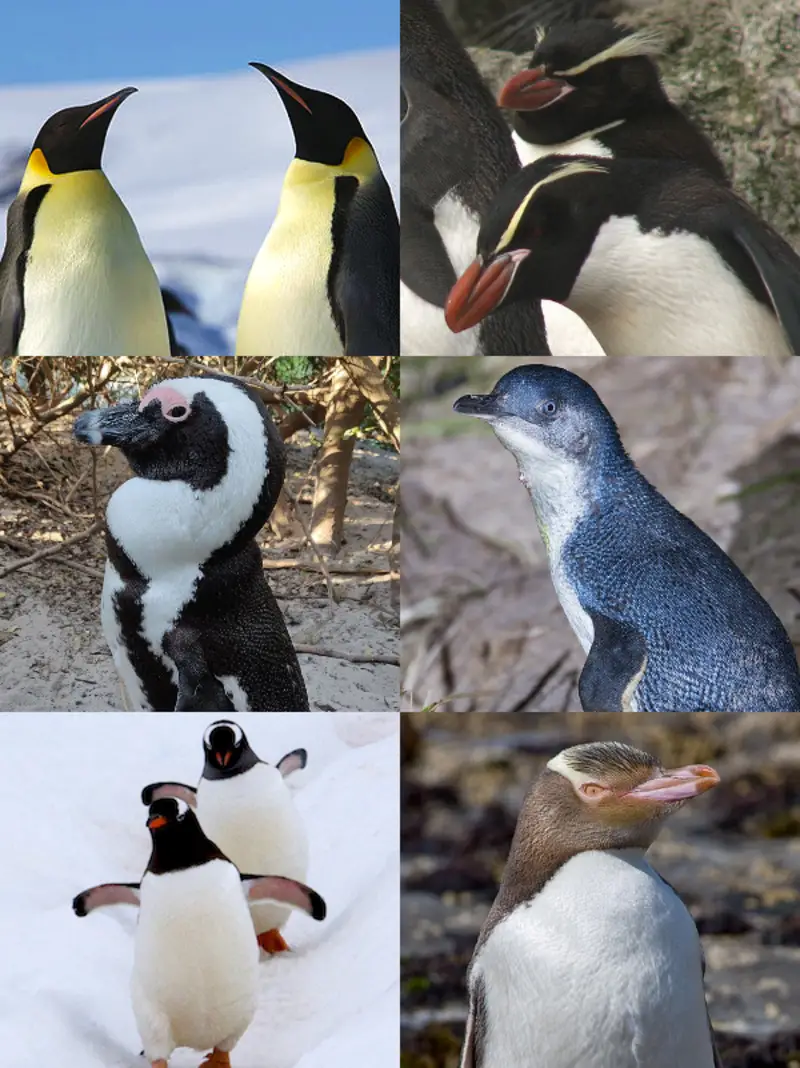
Penguins are an amazing species of aquatic birds that live mainly in the Southern Hemisphere. They have a unique plumage, which is black and white countershaded to aid them while swimming in the water.
Penguins feed mostly on krill, small crustaceans found near Antarctica. These remarkable creatures can’t fly but they compensate by being excellent swimmers due to their flippers-like wings which help them move faster underwater.
All this makes penguins one of nature’s most fascinating animals – not just for kids.Scientific classification:
| Kingdom | Animalia |
| Phylum | Chordata |
| Class | Aves |
| Clade | Austrodyptornithes |
| Order | Sphenisciformes Sharpe, 1891 |
| Family | Spheniscidae Bonaparte, 1831 |
Also Featured In: Antarctica Birds, Birds that Live in the Ocean
21. Hawaiian Hawk

The Hawaiian hawk, or ʻio is an endemic raptor found only on the Big Island of Hawaii. It is one of two birds of prey native to the island – the other being a short-eared owl.
Evidence suggests that it once inhabited five islands in total but today can only be found on the Big Island.
This beautiful bird has distinctive white feathers and yellow legs and feet with its diet including small mammals, reptiles, insects and carrion which they hunt from above using their sharp vision.
The ‘Io plays an important role in keeping ecosystems balanced by controlling rodent populations as well as helping disperse seeds through consumption providing biodiversity for various plants across different regions within Hawaii’s forests and grasslands.Scientific classification:
| Kingdom | Animalia |
| Phylum | Chordata |
| Class | Aves |
| Order | Accipitriformes |
| Family | Accipitridae |
| Genus | Buteo |
| Species | B. solitarius |
Also Featured In: Hawaii Birds, Hawaii Big Island Birds You Should Know
22. Old World Sparrows
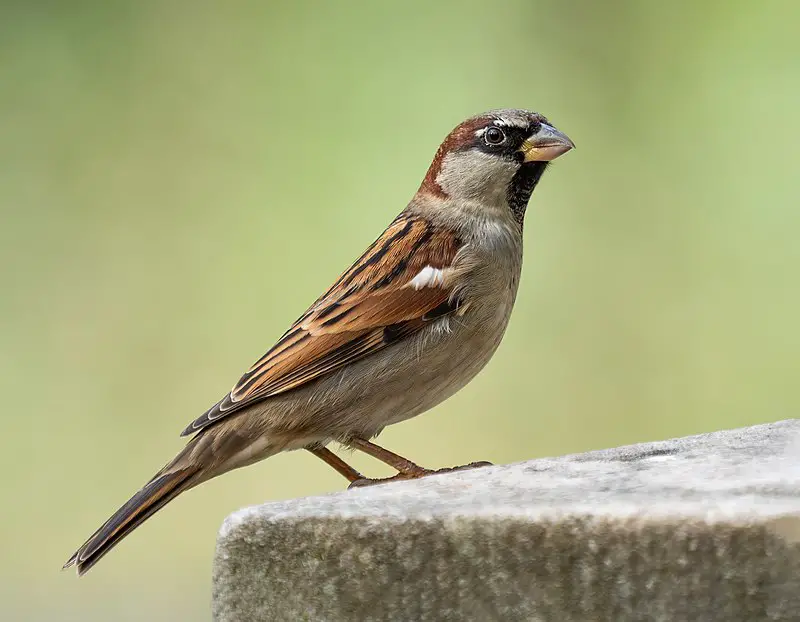
Old World sparrows are small passerine birds belonging to the family Passeridae. They are characteristically much smaller than their New World counterparts, ranging in size from 6 centimeters up to 20 centimeters depending on species.
The most common characteristics of these birds include a black or grey head and upper body with white underparts and white stripes above their eyes.
Notable features such as barring and streaking can be found across different species within this group.
Old world sparrows typically inhabit open grassland areas but have been known to nest around human dwellings near urban settings as well, making them easily recognizable by many people all over the globe.Scientific classification:
| Kingdom | Animalia |
| Phylum | Chordata |
| Class | Aves |
| Order | Passeriformes |
| Suborder | Passeri |
| Infraorder | Passerida |
| Superfamily | Passeroidea |
| Family | Passeridae Rafinesque, 1815 |
Also Featured In: Alaska Birds, Most Common Winter Birds
23. Sandpiper
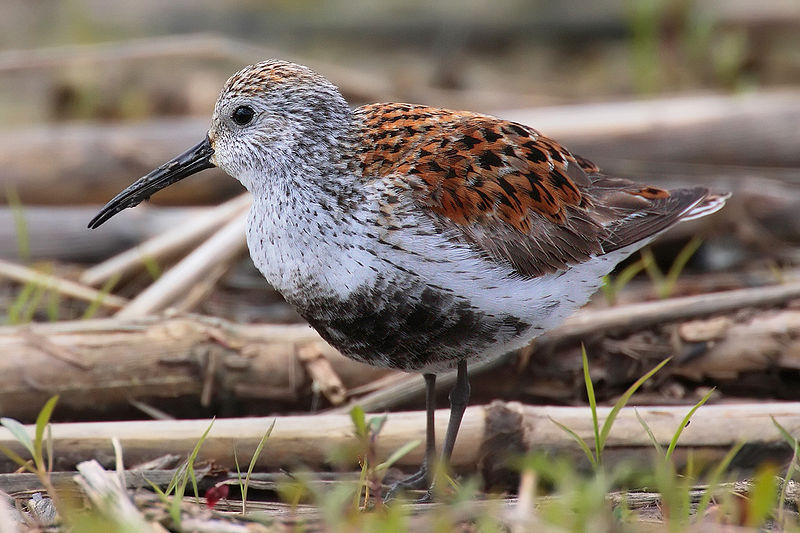
Sandpiper is a type of wading bird that belongs to the family Scolopacidae. It is a diverse family that includes various species such as curlew and snipe.
Sandpipers have different bill lengths that allow them to feed on small invertebrates and creatures found in mud or soil.
Due to this diversity, different species can coexist in the same habitat without competing for food.
Sandpipers are commonly found near the coast but are also found in other wetland environments.
They are known for their slender legs, long beak, and streamlined body that enables them to move easily in and out of water.
Sandpipers are a unique and fascinating bird species that are interesting to observe in their natural habitat.Scientific classification:
| Kingdom | Animalia |
| Phylum | Chordata |
| Class | Aves |
| Order | Charadriiformes |
| Suborder | Scolopaci |
| Family | Scolopacidae Rafinesque, 1815 |
Also Featured In: Birds You’ll Find in the Sea, Turkey Birds You Should Know
24. Owls
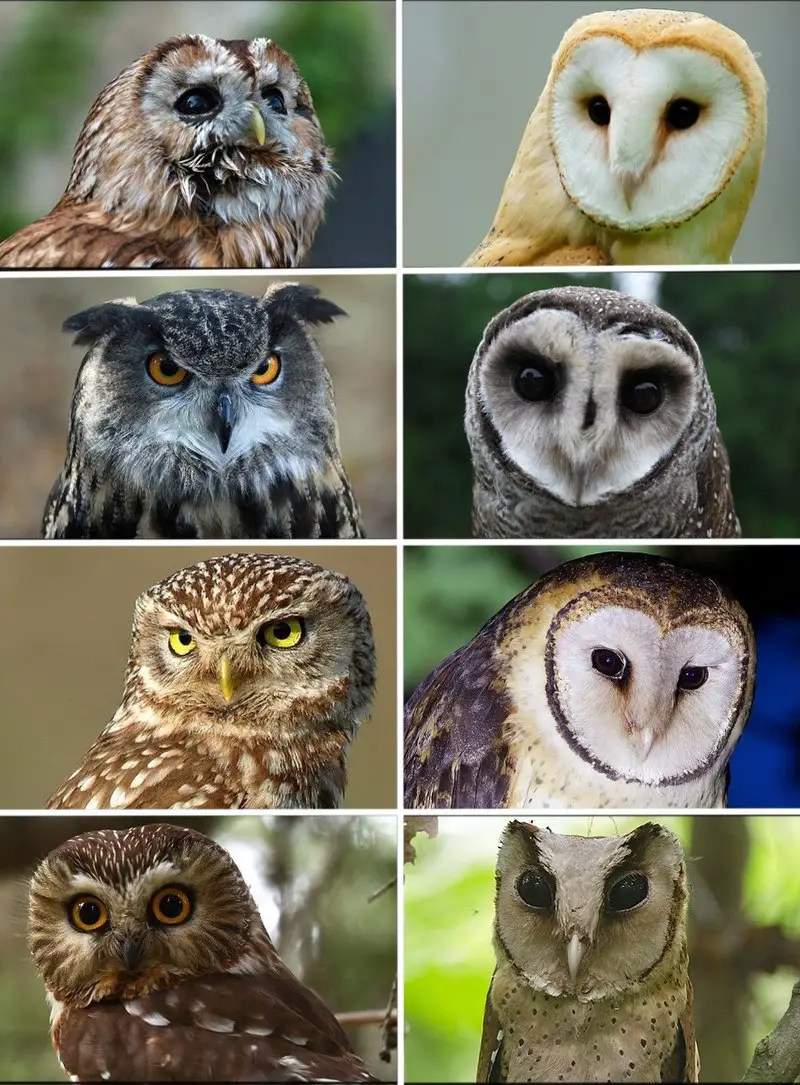
Owls are remarkable birds of prey that belong to the order Strigiformes. Known for their solitary and nocturnal behavior, these birds are commonly associated with an upright stance, broad head, binocular vision, binaural hearing, sharp talons, and specially adapted feathers for silent flight.
With over 200 species, owls are mostly carnivorous and hunt small mammals, making them excellent at controlling rodent populations.
Although most owls are solitary animals, some species, such as the gregarious burrowing owl, are social and interact regularly with their own kind.
Despite their nocturnal habits, some owls, like the northern hawk-owl, are diurnal and hunt during daylight hours.
All in all, owls are fascinating creatures that have intrigued bird watchers and scientists alike for many years.Scientific classification:
| Kingdom | Animalia |
| Phylum | Chordata |
| Class | Aves |
| Clade | Telluraves |
| Order | Strigiformes Wagler, 1830 |
Also Featured In: Famous Paintings Birds, Flight Birds You Should Know
25. Red-Shouldered Hawk
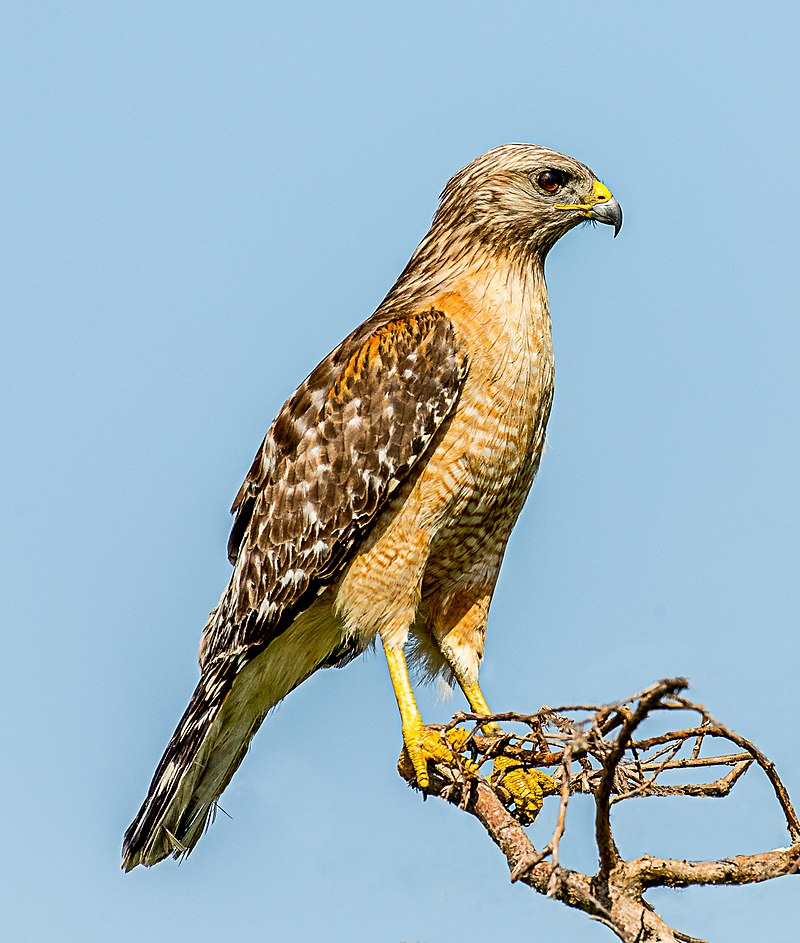
The red-shouldered hawk, also known as Buteo lineatus, is a medium-sized bird of prey found in eastern North America and along the coast of California and northern to northeastern-central Mexico.
While many of these hawks are permanent residents within their range, northern populations do migrate, with most traveling to central Mexico.
The species faces numerous threats to its survival, with deforestation being a primary issue.
Despite the many challenges they face, these birds are an important part of their ecosystems, primarily feeding on rodents, small mammals, and amphibians.
In addition to their hunting capabilities, these hawks are known for their striking appearance, featuring reddish brown shoulder feathers and bold black and white striped wings.
Overall, the red-shouldered hawk is a fascinating and important bird that plays a vital role in its surroundings.Scientific classification:
| Kingdom | Animalia |
| Phylum | Chordata |
| Class | Aves |
| Order | Accipitriformes |
| Family | Accipitridae |
| Genus | Buteo |
| Species | B. lineatus |
Also Featured In: Birds Live Near San Diego, Birds Commonly Found in New York
26. Milvus
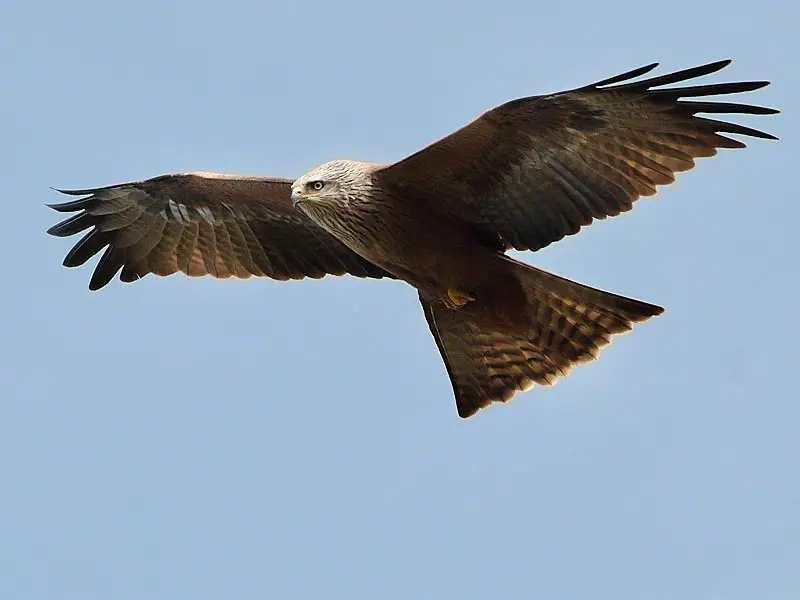
The Milvus genus is comprised of medium-sized birds of prey, with the red kite being the type species. This group is part of the subfamily Milvinae and contains three species.
The name Milvus is derived from the Latin word for the red kite. According to allozyme data, both black and red kites have significant genetic diversity.
These birds are found primarily in the Old World and are known for their hunting abilities.
Overall, the Milvus genus is a fascinating group of birds that play an important role in their respective ecosystems.Scientific classification:
| Kingdom | Animalia |
| Phylum | Chordata |
| Class | Aves |
| Order | Accipitriformes |
| Family | Accipitridae |
| Subfamily | Milvinae |
| Genus | Milvus Lacépède, 1799 |
Also Featured In: Common Birds in the Cities,
27. Galapagos Hawk
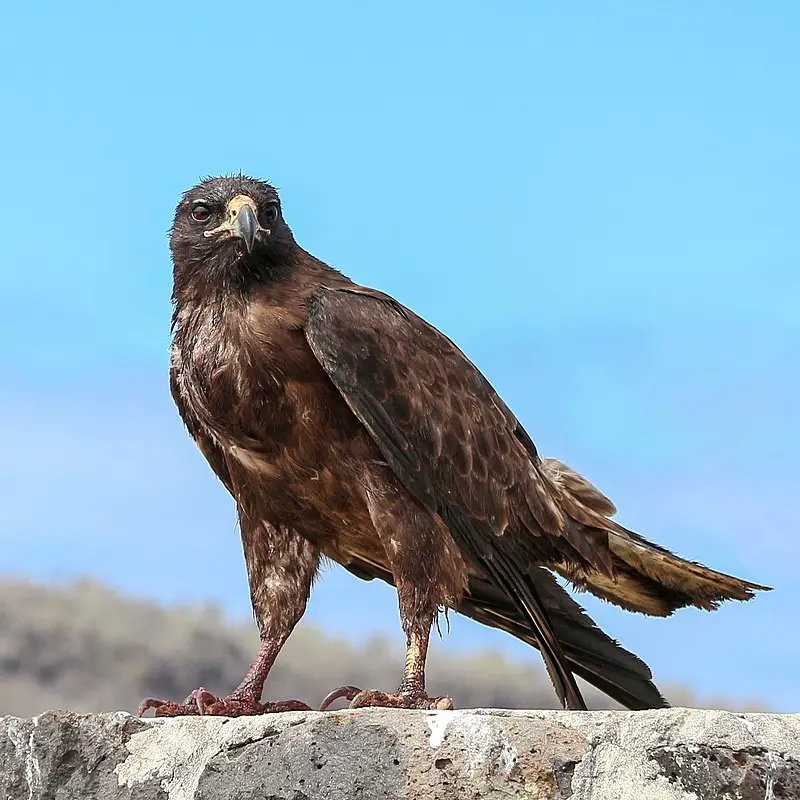
The Galápagos hawk is a native bird species found across the Galápagos Islands. It is similar in size to the red-tailed hawk and Swainson’s hawk of North America, although its size varies across the different islands.
These hawks are known for their heavy build, which makes them stand out from other bird species in the region.
They are also known for their unique adaptations and behaviors that have allowed them to thrive in their specific island habitats.
As a result, the Galápagos hawk has become an iconic part of the Galápagos ecosystem, and is often studied and admired by tourists and researchers who visit the islands.Scientific classification:
| Kingdom | Animalia |
| Phylum | Chordata |
| Class | Aves |
| Order | Accipitriformes |
| Family | Accipitridae |
| Genus | Buteo |
| Species | B. galapagoensis |
Also Featured In: Galapagos Birds You Should Know, Birds of Galápagos Islands You Need to Know
28. Crowned Eagle
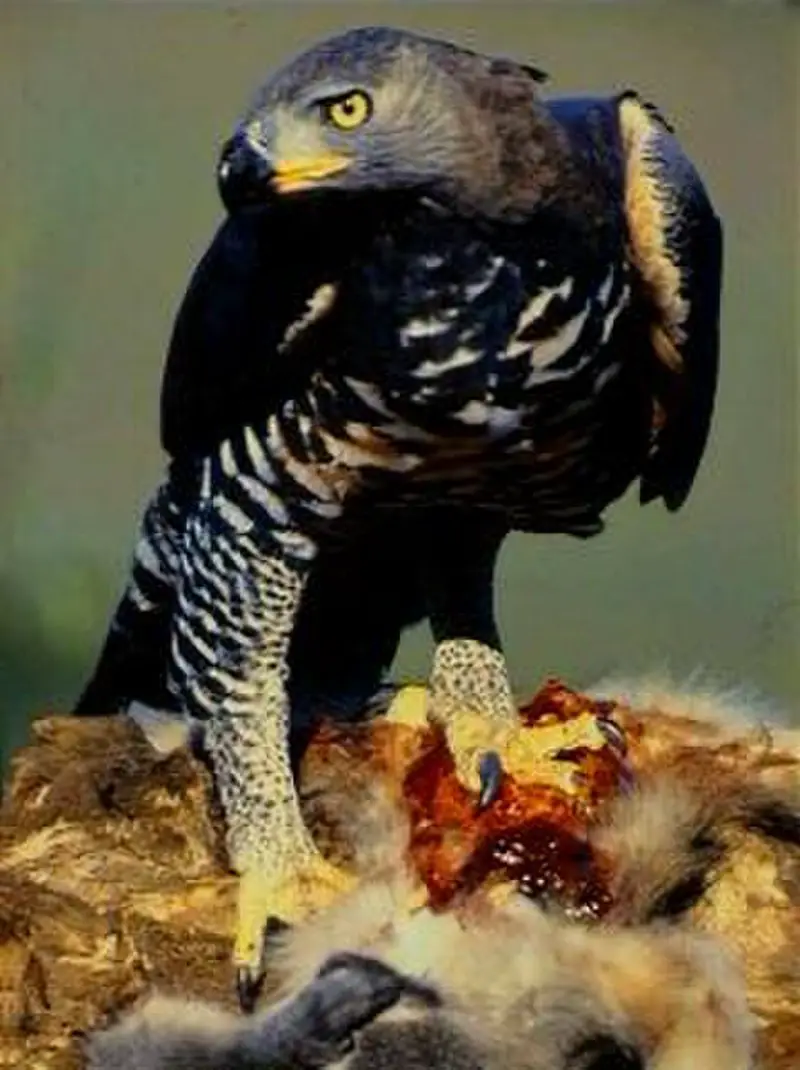
The Crowned eagle, also known as the African crowned eagle or the crowned hawk-eagle is commonly found in sub-Saharan Africa. This bird of prey prefers riparian woodlands and forests.
It is the only living member of the genus Stephanoaetus. Though in Southern Africa, it is limited to eastern areas.
The Crowned eagle is a large bird with impressive hunting skills. They are known to hunt medium-sized mammals like guinea fowl, rabbits, and hares.
The females are larger than the males and have a wingspan of over 6 feet. Their striking appearance and powerful talons make them an important symbol in African cultures.
However, the Crowned eagle is threatened by habitat destruction and hunting, which has resulted in a decrease in their population.
Conservation efforts are underway to protect this impressive bird of prey.Scientific classification:
| Kingdom | Animalia |
| Phylum | Chordata |
| Class | Aves |
| Order | Accipitriformes |
| Family | Accipitridae |
| Genus | Stephanoaetus |
| Species | S. coronatus |
Also Featured In: African Rainforest Birds, Big Birds that Live in Uganda
29. Barred Hawk
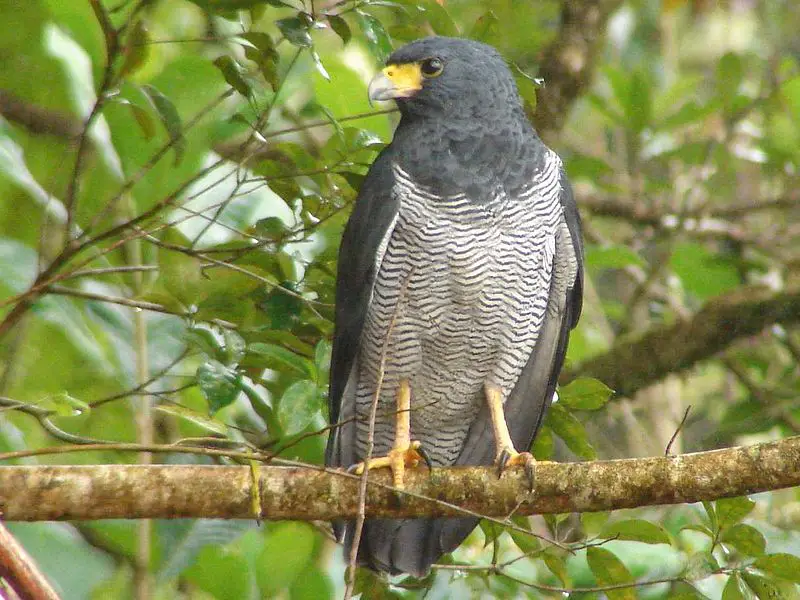
The Barred hawk, also known as the black-chested hawk, is a bird of prey in the Accipitridae family.
It is found in several South American countries and prefers to live in subtropical or tropical moist lowland forests and montane forests.
It is estimated that between 10,000 to 100,000 Barred hawks exist in Central and South America.
These birds are known for their striking black and white barred pattern on their wings and tail, which makes them easy to identify. They are powerful hunters, feeding on small mammals, reptiles, and birds.
Unfortunately, their population is declining, and they are considered threatened due to habitat loss and deforestation in their natural habitats.
Conservation efforts need to focus on protecting their habitats and raising awareness about the importance of preserving these magnificent birds.Scientific classification:
| Kingdom | Animalia |
| Phylum | Chordata |
| Class | Aves |
| Order | Accipitriformes |
| Family | Accipitridae |
| Genus | Morphnarchus Ridgway, 1920 |
| Species | M. princeps |
30. True Eagles
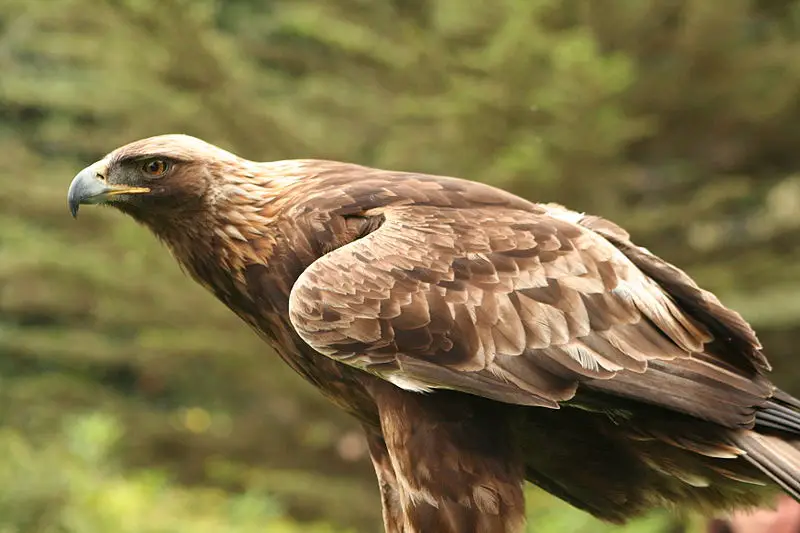
True eagles are a remarkable genus of birds of prey. They are often distinguished from other birds, such as sea eagles and accipitrine hawks, due to their heavier build.
The Latin name for this genus, Aquila, means eagle and is possibly derived from the word aquilus, meaning dark in color.
True eagles are not a natural group, but rather a category that encompasses various birds of prey.
They are known for their incredible hunting abilities and powerful talons, which they use to capture their prey.
True eagles are a majestic sight to behold and are revered in many cultures as symbols of strength and freedom.
Despite being less distinct from other birds of prey than previously believed, true eagles remain a fascinating and awe-inspiring species.Scientific classification:
| Kingdom | Animalia |
| Phylum | Chordata |
| Class | Aves |
| Order | Accipitriformes |
| Family | Accipitridae |
| Subfamily | Aquilinae |
| Genus | Aquila Brisson, 1760 |
31. Red-Legged Seriema
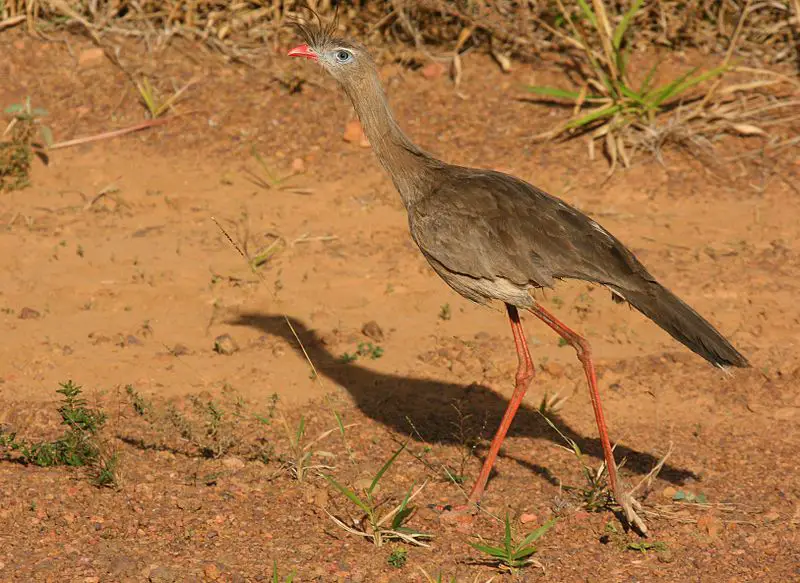
The Red-legged seriema, also known as the crested cariama, is a predatory bird found mainly on the ground. It belongs to the Cariamidae family and was previously included in the Gruiformes order.
Recently, it has been placed in a distinct order known as Cariamiformes, along with three extinct families.
The bird is widely distributed and can be found in various parts of the world. The Red-legged seriema has a distinctive appearance, with a crested head and red legs.
It is known to prey on small animals and can use its strong beak to catch and eat them. Due to their unique characteristics and hunting abilities, the Red-legged seriema is a fascinating bird that many people enjoy watching and studying.Scientific classification:
| Kingdom | Animalia |
| Phylum | Chordata |
| Class | Aves |
| Order | Cariamiformes |
| Family | Cariamidae |
| Genus | Cariama Brisson, 1760 |
| Species | C. cristata |
32. Aquilinae
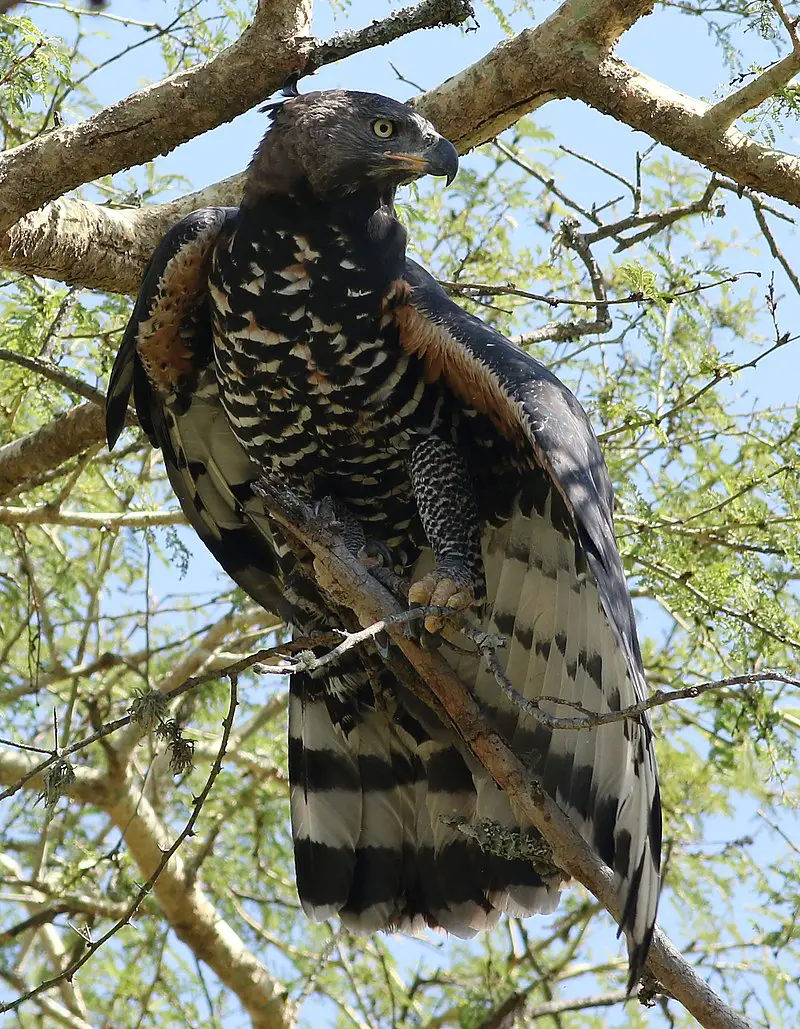
The Aquilinae is a subfamily of eagles from the Accipitridae family. Often referred to as “booted eagles,” they possess certain shared characteristics with buzzards and buteonine hawks, leading to past consideration of alignment with those subfamilies.
However, booted eagles are distinct in their own right and are recognized as such. Their name is derived from the feather-covered legs, or “boots,” that distinguish them from other birds of prey.
With remarkable physical capabilities and impressive hunting skills, Aquilinae birds are known for their distinctive appearance and prowess in the wild.Scientific classification:
| Kingdom | Animalia |
| Phylum | Chordata |
| Class | Aves |
| Order | Accipitriformes |
| Family | Accipitridae |
| Subfamily | Aquilinae |
33. Aegypiinae
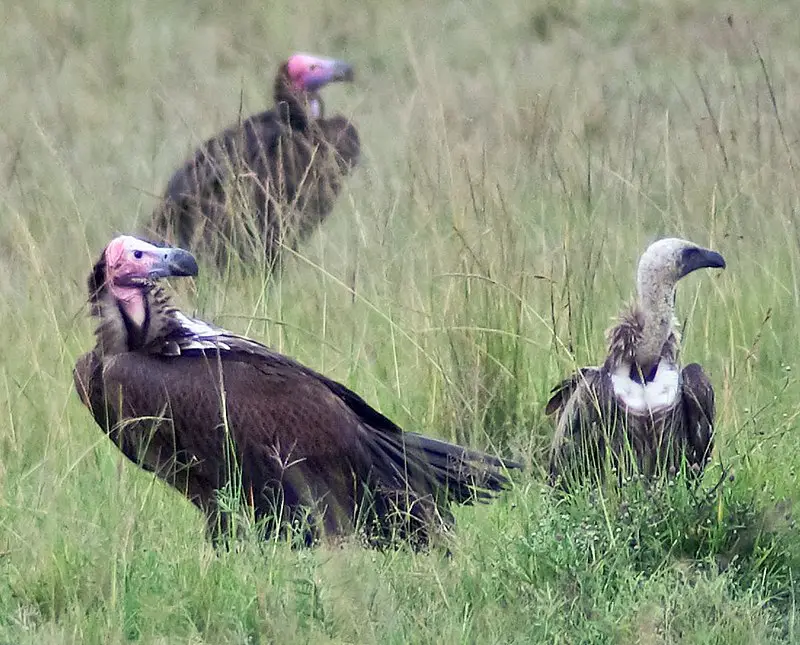
Aegypiinae birds are a subfamily of Accipitridae that are commonly known as Old World vultures. They are distinct from the Gypaetinae subfamily, which is a separate group of birds.
Aegypiinae birds are believed to have evolved from the same ancestor as the serpent-eagles, which are classified under the Circaetinae subfamily. These birds are found in several regions, including Africa, Asia, and certain parts of Europe.
Fossil records indicate that these birds were present during the Late Pleistocene era. Aegypiinae birds are known for their scavenging behavior and feed on carrion. They have sharp beaks and talons that help them to rip apart flesh.
Despite their diet, they play an important role in maintaining the ecological balance and are an essential part of the food chain.Scientific classification:
| Kingdom | Animalia |
| Phylum | Chordata |
| Class | Aves |
| Order | Accipitriformes |
| Family | Accipitridae |
| Subfamily | Aegypiinae |
34. Buteoninae
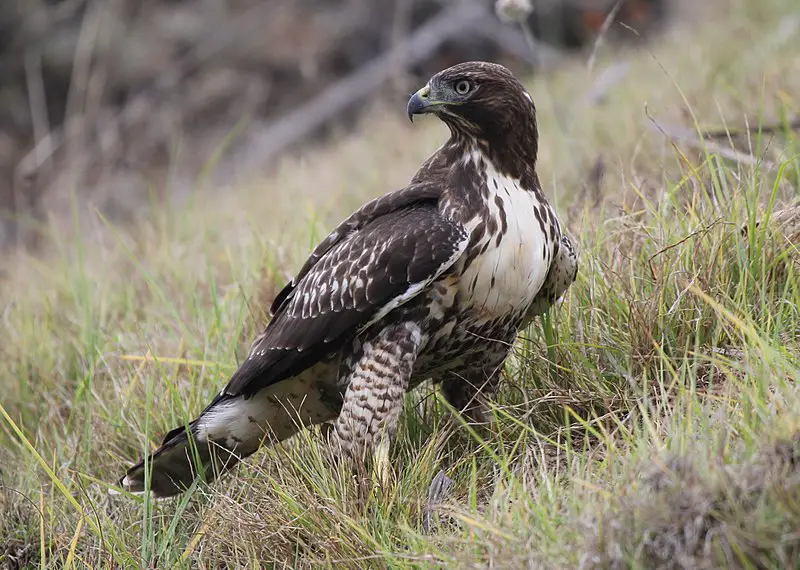
Buteoninae birds are a subfamily of rapacious birds, known for their large size and broad wings. These birds have a powerful hooked beak, which they use to tear flesh from their prey.
Their legs and talons are also very strong, aiding them in catching their food. These birds possess remarkable eyesight, enabling them to locate prey even from afar.
The buzzards, which are also considered buteonine hawks, belong to this subfamily, displaying a wide range of distinct appearances.Scientific classification:
| Kingdom | Animalia |
| Phylum | Chordata |
| Class | Aves |
| Order | Accipitriformes |
| Family | Accipitridae |
| Subfamily | Buteoninae |
35. Teratornis
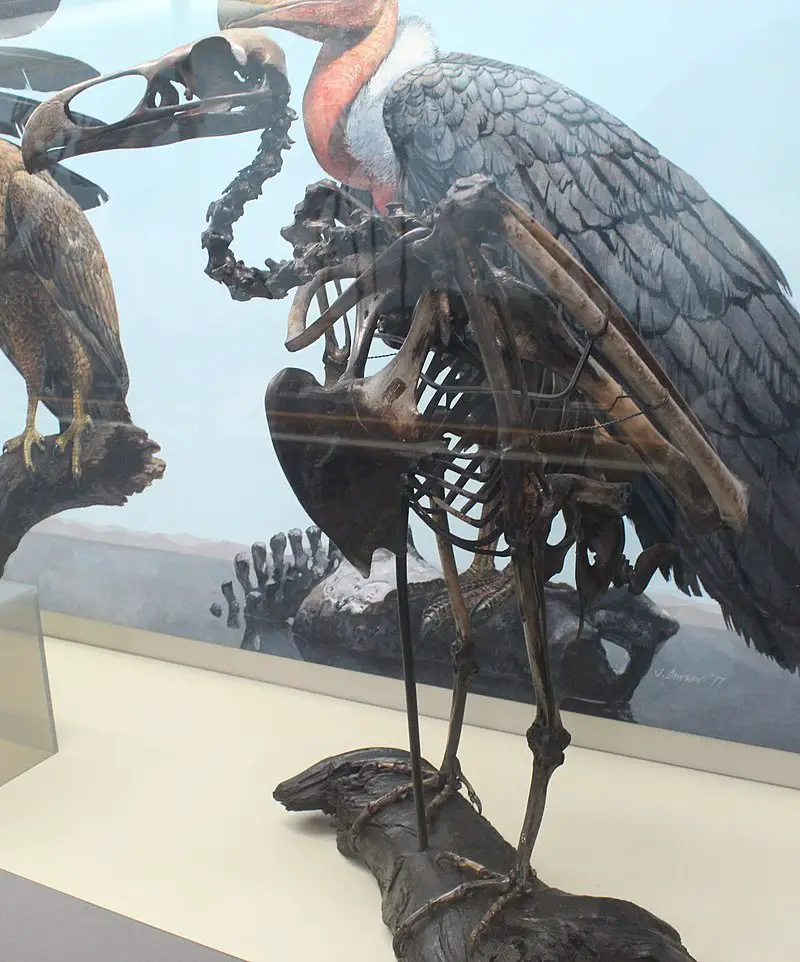
Teratornis was a genus of massive birds of prey that lived in North America. The name comes from the Greek words for “wonder” and “bird.” Two known species of Teratornis were Teratornis merriami and Teratornis woodburnensis.
Over 100 individual fossils and subfossils have been discovered in California, Oregon, southern Nevada, and Arizona.
These birds were enormous and likely had powerful talons and sharp beaks for hunting. It is believed that they were scavengers, feeding on carrion and possibly hunting smaller animals.
Despite their formidable size and strength, Teratornis eventually became extinct, likely due to climate change and human hunting.
Nonetheless, the discovery of their fossils provides valuable information about the natural history and ecology of North America during the Pleistocene epoch.Scientific classification:
| Kingdom | Animalia |
| Phylum | Chordata |
| Class | Aves |
| Order | Cathartiformes |
| Family | †Teratornithidae |
| Genus | †Teratornis L. H. Miller, 1909[1] |